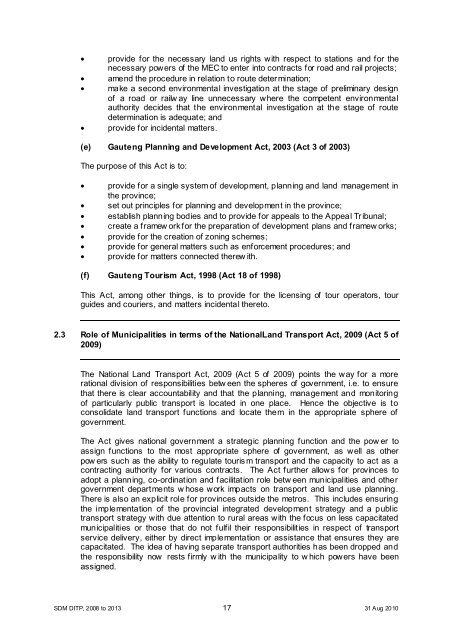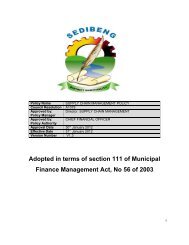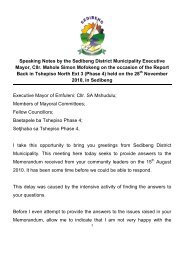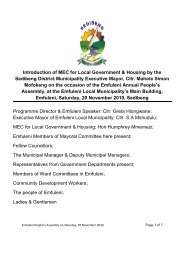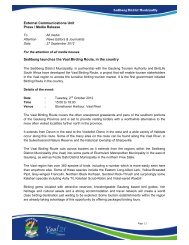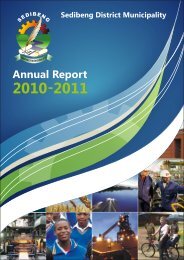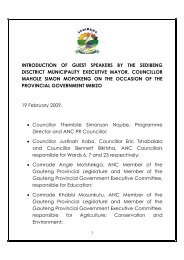Chapter 11 - Sedibeng District Municipality
Chapter 11 - Sedibeng District Municipality
Chapter 11 - Sedibeng District Municipality
You also want an ePaper? Increase the reach of your titles
YUMPU automatically turns print PDFs into web optimized ePapers that Google loves.
• provide for the necessary land us rights with respect to stations and for the<br />
necessary powers of the MEC to enter into contracts for road and rail projects;<br />
• amend the procedure in relation to route determination;<br />
• make a second environmental investigation at the stage of preliminary design<br />
of a road or railw ay line unnecessary where the competent environmental<br />
authority decides that the environmental investigation at the stage of route<br />
determination is adequate; and<br />
• provide for incidental matters.<br />
(e) Gauteng Planning and Development Act, 2003 (Act 3 of 2003)<br />
The purpose of this Act is to:<br />
• provide for a single system of development, planning and land management in<br />
the province;<br />
• set out principles for planning and development in the province;<br />
• establish planning bodies and to provide for appeals to the Appeal Tribunal;<br />
• create a framew ork for the preparation of development plans and framew orks;<br />
• provide for the creation of zoning schemes;<br />
• provide for general matters such as enforcement procedures; and<br />
• provide for matters connected therew ith.<br />
(f) Gauteng Tourism Act, 1998 (Act 18 of 1998)<br />
This Act, among other things, is to provide for the licensing of tour operators, tour<br />
guides and couriers, and matters incidental thereto.<br />
2.3 Role of Municipalities in terms of the NationalLand Transport Act, 2009 (Act 5 of<br />
2009)<br />
The National Land Transport Act, 2009 (Act 5 of 2009) points the way for a more<br />
rational division of responsibilities betw een the spheres of government, i.e. to ensure<br />
that there is clear accountability and that the planning, management and monitoring<br />
of particularly public transport is located in one place. Hence the objective is to<br />
consolidate land transport functions and locate them in the appropriate sphere of<br />
government.<br />
The Act gives national government a strategic planning function and the pow er to<br />
assign functions to the most appropriate sphere of government, as well as other<br />
pow ers such as the ability to regulate touris m transport and the capacity to act as a<br />
contracting authority for various contracts. The Act further allows for provinces to<br />
adopt a planning, co-ordination and facilitation role betw een municipalities and other<br />
government departments w hose work impacts on transport and land use planning.<br />
There is also an explicit role for provinces outside the metros. This includes ensuring<br />
the implementation of the provincial integrated development strategy and a public<br />
transport strategy with due attention to rural areas with the focus on less capacitated<br />
municipalities or those that do not fulfil their responsibilities in respect of transport<br />
service delivery, either by direct implementation or assistance that ensures they are<br />
capacitated. The idea of having separate transport authorities has been dropped and<br />
the responsibility now rests firmly w ith the municipality to w hich powers have been<br />
assigned.<br />
SDM DITP, 2008 to 2013 17 31 Aug 2010


